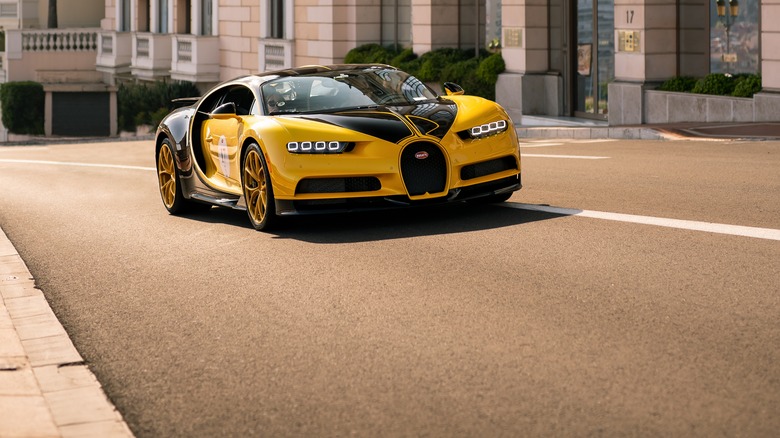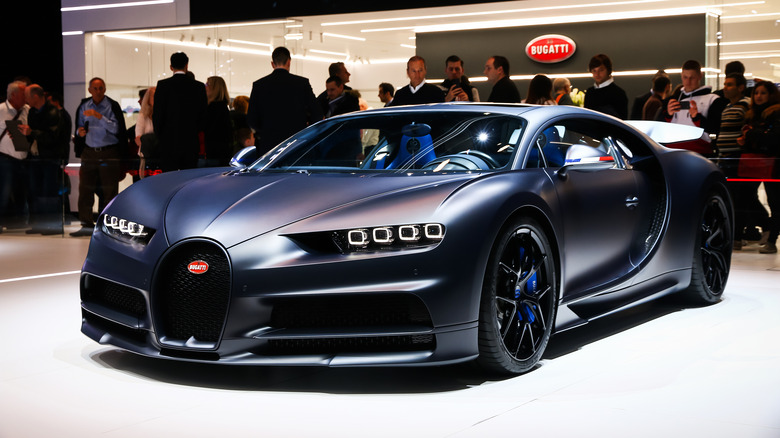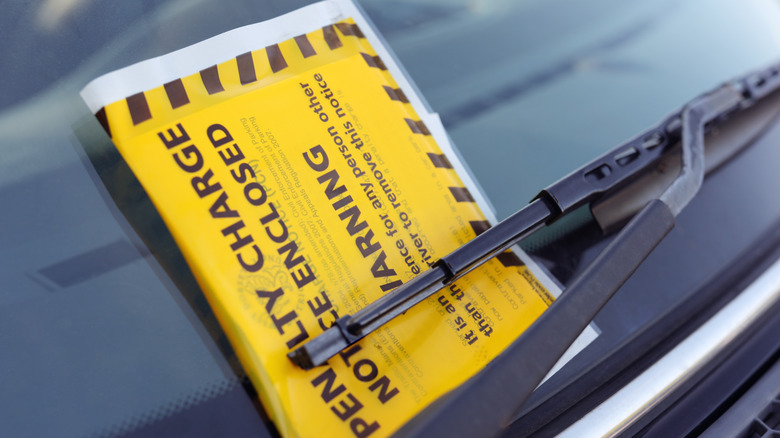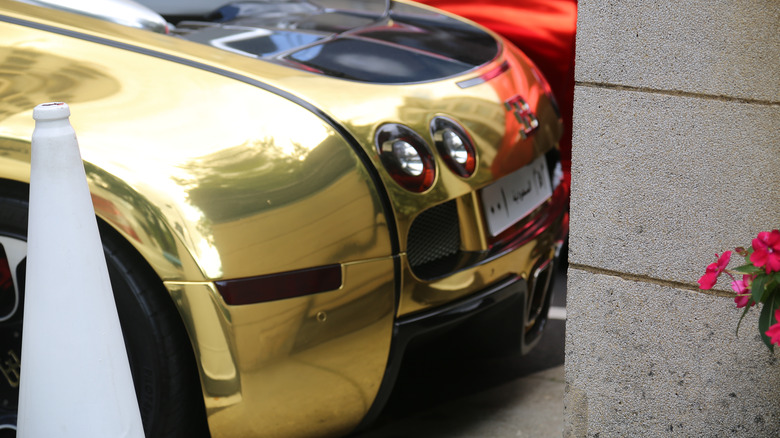Rules To Follow When Driving A Bugatti
Mention the name Bugatti, and anyone with even a vague interest in cars will think of the Veyron. A 1,000-horsepower beast that shook the motoring world in the early 2000s and snatched the title of world's fastest production car from the equally exclusive and expensive McLaren F1. But the company's legacy goes back far beyond the Veyron. The Italian company was founded by a man called Ettore Bugatti in 1909, and like fellow luxury car makers Bentley saw a fair amount of success on the race track during its early years. Things went downhill just before World War Two when Bugatti's son and heir to the company Jean died after crashing one of the carmaker's prototypes. Old Ettore decided to flee to Paris instead of helping Hitler out, and following the war came back to a factory left in ruins. He died in 1947, and his company went the same way a few years later.
But that wasn't the end for Bugatti. The company's name changed hands throughout the 1960s, '70s, and '80s, before Romano Artioli, an Italian entrepreneur who had been eyeballing the company since it initially closed its doors in 1952, came into the possession of Bugatti. Artioli went through several prototypes and built a new factory before the Bugatti EB 110 came into being. Though the company was soon in severe financial troubles, and only 128 EB 110s were built before the second major incarnation of Bugatti went the same way as the first in 1995. However, another revival wasn't too far away. Volkswagen bought the Bugatti brand in 1998 and transformed it into the high-end automotive powerhouse you see today.
Why you should stay on Bugatti's good side
Like many other ultra-high-end car companies, Bugatti doesn't have a high output. With longer-running cars like the Chiron, the company produced around 70 vehicles per year (via The Verge). The upcoming Bugatti W16 Mistral is even more limited; only 99 will ever be made. Despite the astronomical price tag, there are more than 70 people who can both afford and would like to have a new Bugatti.
This supply and demand situation probably isn't something Bugatti wants to rectify. The exclusivity and attention to detail are both key selling points and help preserve the status of the multi-million dollar vehicles. This isn't a criticism of Ford, but it's easy to assume less care goes into the thousands of Fusions that roll off the production line every year. If you're the sort of obscenely rich individual who can put a Bugatti in your garage, your tastes aren't likely to include things everyone else could theoretically have.
So with extremely limited supply and very high demand, Bugatti is in a position where it can be very choosy about who it sells a car to. While some companies court customers and do everything they can to keep those customers coming back, Bugatti can afford to lose them or just not have them in the first place. Even if you're a member of the elite, buying a Bugatti is seen as a privilege that few manage to gain and that can just as easily be lost.
Make sure you have the cash to keep it going
If you've been lucky enough to purchase a new Bugatti and the multi-million dollar sticker price has left you reeling, we have some bad news. The Italian hypercar isn't done with your wallet. Bugattis are incredibly impressive pieces of engineering, and vehicles like that are obscenely expensive to maintain and complex to work on. Throwing Bubba's Backyard Garage $200 to install Aacheap aftermarket part from China isn't going to cut it with a car of this caliber.
Other models may be even pricier, but one Veyron owner, Manny Khoshbin, outlined how much his pride and joy costs to maintain. A regular service where the vehicle's oil, filters, and fuels are replaced will set you back $25,000. The wheels should ideally be replaced every 10,000 miles, and that will set you back a staggering $50,000. Khoshbin estimates maintaining a Veyron costs around $100,000 every 10,000 miles.
The Veyron's W16 engine, which is basically two V8s that have been welded together, has four turbochargers. According to documentation filed with the EPA (opens as a PDF) those cost $6,400 a piece, and the labor costs of a replacement can set you back $9,000 a pair. A fuel tank is $20,000, and you'll need another $22,000 if you want someone who actually knows what they're doing to fit it to the car. You could put repairs off and let your very expensive car degrade, but this may hurt its value, lead to bigger problems, and annoy Bugatti to the point where they refuse to deal with you again.
Don't go flat out for too long
Bugatti's cars are immensely powerful. Some of them are capable of producing well in excess of 1,000 horsepower and moving at speeds of over 300 miles per hour. The Veyron may be a little older, but it is by no means sluggish. You still get at least 1,000 horsepower and if you're flat out you'll be traveling at more than 250 miles per hour. This level of speed is part of what you're paying for with these cars, and it is something a lot of Bugatti owners will try out if they get the opportunity. However, producing that kind of speed has its consequences.
As Robb Report pointed out, traveling flat out in a Veyron will destroy the tires within 15 minutes. Bugatti parts are expensive, and replacing those tires will set you back $38,000. However, unless they've already been worn down, maxing out the speedometer doesn't mean your tires are going to cause you issues on the road. That sort of performance also requires a lot of fuel. At top speed, the Veyron will drink its entire fuel tank in just 12 minutes, which should hopefully leave you enough rubber to get to a tire shop once you've refilled the tank.
You can park where you want, sort of
Then again, if you're in a position where you can drop $5 million on a car, $38,000 for tires is probably pocket change and a sub-$100 parking fine probably doesn't even register as an amount of money to you. This may explain why Bugatti owners seem to park where they want almost all of the time. A few times a year, a paper like the Irish Daily Mirror will have a slow news day and take the opportunity to fill a few column inches with a story about a Bugatti or something similar getting ticketed for parking somewhere it shouldn't.
So, why wouldn't a Bugatti driver just use a regular parking spot like a normal human being? Well, as we've pointed out, they're not normal. They're obscenely rich. The couple of quarters a regular person throws in a parking meter are probably a larger portion of that normal person's net worth than a $75 parking ticker is to a billionaire's. Then there's convenience. Why drive around looking for a spot or a garage, then walk two or three blocks to get where you want to go? Just check you're not in a tow zone, because that would inconvenience you, then park your hypercar right in front of where you need to be. Finally, there's the whole showing-off aspect. People who want to fly under the radar rarely buy one of the world's exclusive cars. You're going to get noticed in a Bugatti. If general recognition isn't enough, a few parking violations could place your pride and joy in a prominent position outside a well-known hotel or restaurant; get you a mention in the newspapers; or land you in the parking fine record books.
Don't bling it to death
Given the company's success and the desirability of its products, it's safe to say Bugatti knows what its doing when it comes to making cars. Bugatti makes some of the most advanced road cars on the planet, and has produced vehicles that have snagged the title of "world's fastest production car" on two separate occasions. The team at Bugatti doesn't just excel at engineering, the cars are also beautifully styled. The cars have a beautiful aerodynamic shape that is aesthetically pleasing and also responsible for a good amount of the car's performance. Then there are the two-tone paintjobs that compliment the car's styling wonderfully.
So why do people insist on having vehicles Bugattis gold plated? The most obvious answer is it's all an obnoxious display of extravagance and wealth. But you've already got one of the most expensive cars on the planet, it costs more than a mansion by the ocean, why turn it into a reflective bauble?
Make sure you know how to use the car's basic features
A modern $30,000 sedan comes packed with all kinds of features, so you can expect something as expensive as a Bugatti to have all kinds of conveniences built in. Despite things like touch screen interfaces making menu navigation a bit easier, there is a good chance your car will be capable of one or two things you aren't aware of. That's fine, but at a bare minimum, you should have a grasp of how the car's most basic features, like its doors, operate. Unfortunately, Top Gun star Tom Cruise is guilty of not knowing as much. The actor arrived at the Mission Impossible 3 premiere in a Bugatti Veyron, which isn't out of the ordinary. Major movie premiers are the kind of prestigious events brands like Bugatti like to be associated with, and any actor will look good behind the wheel of one of the world's most desirable vehicles. However, what happened shortly after Cruise arrived landed him on the car maker's blacklist.
After he pulled up to the red carpet, Cruise went to do the gentlemanly thing and open the door for his now ex-wife Katie Holmes. Unfortunately, as the above video illustrates, Maverick couldn't get the door to work and spent a few awkward moments struggling with it finally opened. Brands like Bugatti don't like being made to look bad, especially on high-profile occasions like major film premiers. The incident has allegedly resulted in Bugatti refusing to sell any more of its vehicles to Tom Cruise.



